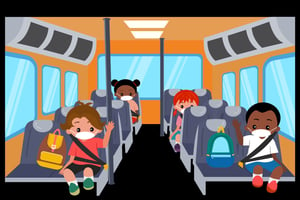School Bus Safety During the COVID-19 Pandemic
published on August 25, 2020 by Sonia Mastros
school bus safety, school bus safety plans, covid-19, coronavirus
 For school districts planning on reopening in the fall, the next few weeks will be spent planning thoroughly on how to reduce the risks of disease spread. COVID-19 is still active throughout North America, so children need to be kept as safe as possible.
For school districts planning on reopening in the fall, the next few weeks will be spent planning thoroughly on how to reduce the risks of disease spread. COVID-19 is still active throughout North America, so children need to be kept as safe as possible.
Ensuring school bus safety will be particularly important. The coronavirus spreads easily in tight quarters, so extra precautions will be called for. These are some of the most important areas to address, according to global experts.
Critical School Bus Safety Must-Dos During the Outbreak
- Encourage parents to keep sick children home. If the child has a cough or a fever, parents should not risk sending them on the bus.
- Students who become sick at school should not be placed on a bus. If there's any risk of infection, keep them isolated until a guardian can retrieve them.
- Encourage hand-washing and sanitizing. Hand cleanliness is still one of the best ways to prevent the spread of COVID-19. If possible, install hand sanitizer stations near the door of each bus, and have students use it whenever they pass by.
- Drivers should pay particular attention to hygiene. Encourage them to sanitize their hands frequently and, if possible, wear a mask throughout each route. Hands should also be sanitized both before and after any direct contact with a student or their possessions.
- Thoroughly disinfect buses after every journey. The bus driver and other attendants should always have access to PPE, paper towels, disinfecting cleaner, and disposal bags. Every surface children might touch must be cleaned.
- Reduce bus capacity. Maintaining distancing between students will be crucial. The fewer students per seat, the better. Ideally, only one per seat, but two if necessary.
- Consider shields and enclosures. If your budget permits bus upgrades, shields or enclosures made of plexiglass or similar materials could be used to help isolate students from the driver, and from each other.
- Encourage bus drivers to take symptoms seriously. Just as with students, a bus driver experiencing a cough or fever should stay home to be safe. A sick driver on a bus could easily infect most or all of the passengers.
- Add more backup drivers to your roster. The coronavirus has left a lot of people out of work or underemployed. This will be an excellent situation for recruiting more drivers and having backups on hand if a driver calls in sick.
Stopping the spread of the coronavirus will truly take a group effort, so it's vital to get everyone on board for these school bus safety measures. In addition to the safety procedures themselves, be sure to engage in plenty of outreach and education among the community!
How is your district planning on protecting your school buses? Let's talk about it in the comments!






